Product Requirements:
Device:
Pocket PC handheld device, Windows CE #.0 or higher,
Approx 300K of memory + memory for databases
Desktop: Windows 95, 98, NT 4.51, ME or
2000, 2.0 Megs of free Hard Disk Space, 32 Megs of RAM recommended, ActiveSync
3.1 or higher.
When I first began my personal migration to using a Pocket PC instead of a Palm
as my full-time PDA; there were a few Palm OS programs that I found I simply
didn’t think I could live without.
Much to Julie’s amusement – and my dismay – I began carrying both my Palm
(for those three programs alone) and my new Pocket PC (for everything else). I
know: this is sad, but it’s true. :0/
One day I just gave up on any of those programs ever being available in the Pocket
PC format. I learned to work around not being able to use them. Every now and
then I would think about the functionality I was missing out on; but my
perceived benefits from other areas of the Pocket PC platform made me stay true to my choice.
One of the essential Palm programs that I sorely missed was HanDBase, by DDH Software.
Now, some of you may be wondering what the big deal about a Database program might
be. Well, the answer to that is simple. By using HanDBase, I am able to keep
everything from the Oil & Gas Well Witnessing reports that I have to
complete and save quarterly, to a gift buying guide for everyone. There is even a totally
customizable meeting minutes generator. In fact there are over 1000 applets in the DDH
Gallery written by people just like you and me, that might save you some time if you aren’t yet confident in your own applet writing
ability.
The truth is, it is so simple to write an applet, that if you follow a few
easy steps – you will soon be creating databases like an old pro.
HanDBase
for Pocket PC, is very similar to the Palm OS version. If you are
comfortable with the original, it will be easy to switch to this version. For
those of you that are familiar with HanDBase, you may want to stick around and
enjoy the overview. For those of you that have never tried it, I’ll try to keep
it as basic as possible – which is not hard to do as this is a very intuitive
and well thought-out program.
So lets get started! The first thing we need to do after installing the
program is create a database. To do this, you will hit the Create a new
database
button on the screen. As you can see, recently opened existing files will also
show up on this start screen to save time.
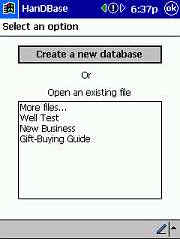
After clicking the Create button, this is the next screen you will
see. Here, you are able to enter the name of your soon-to-be masterpiece,
and all of the fields that you will need to create for answering questions. You
can also edit the field order, should you remember something you needed to note
– after you have already created your list.
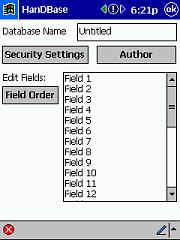
I am going to create a simple database concerning Oil & Gas Well
witnessing. This database will not include any calculating or linking, which are
also functions HanDBase is capable of doing. More on those later….
As I am creating new fields, a pop-up menu will appear. This allows me to
make that field one of many types.
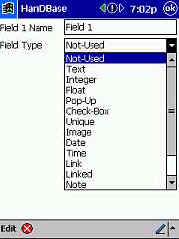
There will be specific features associated with whatever type data you wish
to enter. There is a page on the DDH website that lists all of the field
choice functions, and what they are capable of doing. It is quite
impressive!
Here are my created fields:
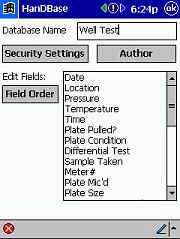
Here is what my new database home page will look like. I have all of the
different fields for information that I have to gather entered; and it is even
possible to further personalize my fields. Due to limitations of the viewing
screen, there is a slider at the bottom so that you can view all of your
different fields.
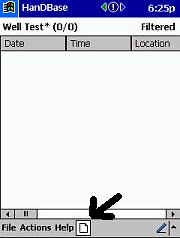
By clicking the New Page button at the bottom of the screen, I am
presented with the form I will use when I am filling out my new data.
Let’s say that this is a form that I will need to use on a regular
basis for a set group of oil & gas wells. I can easily edit the pop-up box
to show the information for wells that I am responsible for witnessing tests on,
by tapping on the “down-arrow” symbol next to each field:
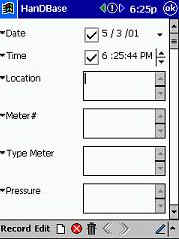
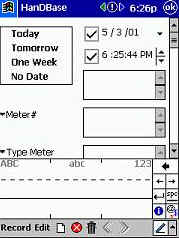
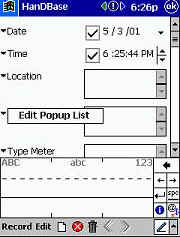
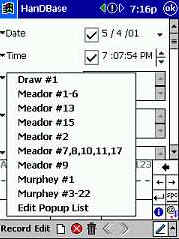
This saves time when entering information, and it is just one of the many
things about this program that shows the thought that went into its creation.
Once you have created and edited your database to your hearts content; there
are some further things you can do to personalize your applet.
You can…
Personalize & add
Comments
Save your database to either main or flash memory
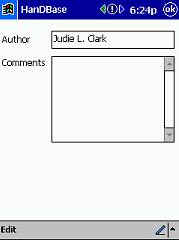
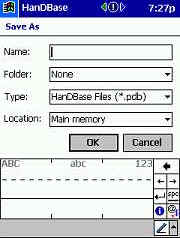
Perform any number of other commands, such as these shown.

One of the most exciting features of the Pocket PC version of HanDBase is the
ability to beam databases not only to and from other Pocket PCs, but also to and
from any of the Palm OS PDAs. I tried this feature and was able to successfully
beam to and from between various Palms and my iPAQ.
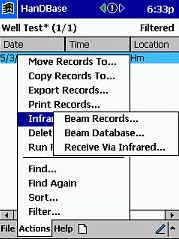
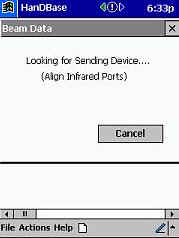
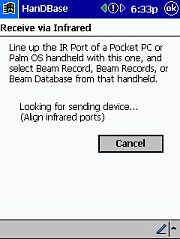
You can even create reports based on any field. To do this, follow these
steps: Hit Actions, then Run Report. You would then pick the field
to base your report on.
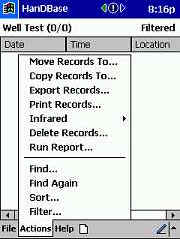
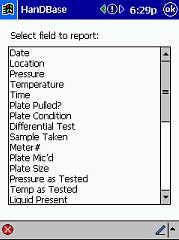
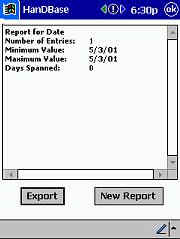
One of the special features of HanDBase is the free desktop companion for
Windows systems. With this program, you can perform all of your editing
from your desktop. Key Features include: Full design, edit, and viewing for
HanDBase databases; the ability to export directly to Excel (MS-Excel 5.0, 95,
97, 2000), CSV, Word, HTML, or XML formats; Plug-In-Architecture for 3rd party
add-ons; Built in menu link to FREE HanDBase Applet Gallery Multiple database
merging; and Tabular and detailed printing options
Here is what the desktop version of my Witness Database looks like:
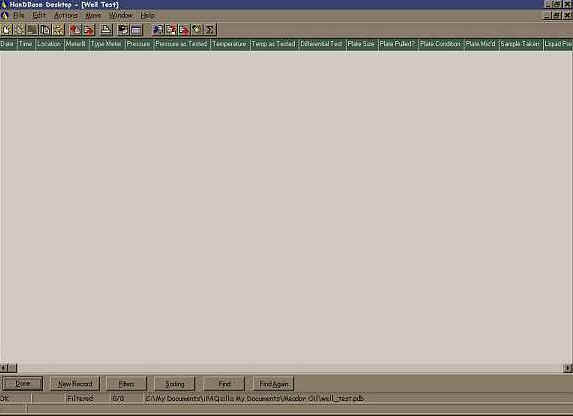
As I mentioned before, it is also possible to link databases. This allows a
“record of one database to act as a key to other databases. This feature
enables users to jump from one relational database to the related items in a
linked database.”
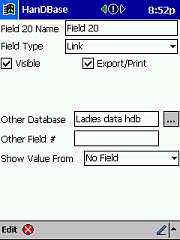
HanDBase is feature rich, and to better understand all of the possible things
you can do with it, you can even download its User
Manual in .pdb format, to read from the program.
Is HanDBase perfect? Not quite. There are some users that will not like the
fact that it can’t integrate with the built in Pocket Access conduit. I don’t
consider this a con, however, because I learned how to make databases on this
program, before I learned how to use Access. HanDBase coupled with the desktop
software works perfectly for my needs.
One of the few quirks to the Pocket PC version that I have found is that the various
Peanut Press books I always have on my Pocket PC show up as HanDBase
databases, as they are in the .pdb format. I never had that happen with the
Palm OS version. I assume that the Pocket PC system searches for all the .pdb files
in a different manner than the Palm does, so that may be why this happens. This
picture is quite small – but if you look closely, you can see a tiny disc on the
“thumbs-up” HanDBase icon. This indicates when a .pdb file is stored
in external memory.
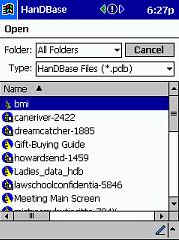
One improvement that I would like to see would be the ability to tap &
hold on a database entry, and have the choice to delete or copy it.
Overall, the addition of HanDBase to my Pocket PC software library has pretty
much made my day! If I live long enough to see those other two software titles
“convert”, then I will be one happy camper!
Price: $24.99
Pros:
Intuitive and easy to use
Massive number of existing free applets available for download
Free Desktop software
Cons:
Some people may not like that it does not integrate with Pocket Access Conduit
OLFA 18mm Heavy-Duty Utility Knife (L-1) - Multi-Purpose Custom Cutting Depth Utility Knife w/Ergonomic Grip Handle & Snap-Off Blade, Replacement Blades: Any OLFA 18mm Blade
11% OffMOZETO Laptop Lunch Backpack for Men, Tactical Inspired Utility Anti-Theft Work Bag with Cooler Compartment Lunchbox (Black, 18 Inch)
10% OffProduct Information
| Price: | $24.99 |
| Manufacturer: | DDH Software |
| Pros: |
|
| Cons: |
|


